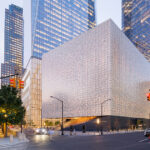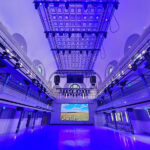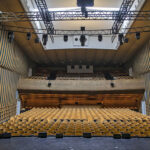Updates reduce control footprint.
“We’re not reinventing the wheel,” says Brendan Quigley, head electrician of the Broadway hit Wicked. “But we are addressing unique problems presented by each venue. This is true for the national tour, as well as the specific designs for the Chicago and Los Angeles productions.”
That Quigley and the rest of Wicked’s technical staff are finding the answers to those problems is borne out by the show’s impressive box-office statistics. Based on Gregory Maguire’s best-selling novel, Winnie Holzman’s book and Stephen Schwarz’s music and lyrics take audiences into the world of the classic Wizard of Oz, relating how the good witch Glinda and her malicious counterpart Elphaba went from friends to mortal enemies. With the original production winning eight Tony Awards, including scenic, costume and lighting design awards as well as Best Musical, the show was destined to become what some have termed “a touring monster,” with both a national company and top-selling local productions.
Of course, that kind of success brings its own set of problems. There’s no resting for Quigley and the other staffers: “Both our producers and the general public have come to expect a certain level of quality from the Wicked productions.” When the goal of the designers is to create an entire on-stage fantasy realm as new yet familiar as the Land of Oz, meeting those expectations takes a lot of hardware. “Our support equipment is defined by the choices made by Kenneth Posner, the show’s lighting designer. ETC fixtures and dimmers, Vari*Lites, Wybron scrollers and specialty equipment like City Theatrical AutoYokes, WDS wireless DMX transmitters and receivers, and MDG smoke and haze machines have been with the show from day one.”
It’s not just the equipment that is familiar to Quigley, though; he has the advantage of working with many of the same technicians who helped to create the original Broadway production. “Bobby Fehribach is the production electrician for all of the North American companies of Wicked. Ken relies on Bobby, and Bobby relies on me and a few others to get the job done. I’ve been there since we started in San Francisco, pre-Broadway. The design team has also remained pretty consistent across all the companies. Karen Spahn, our associate lighting designer, has been with us since the beginning. She’s probably the key player, as she’s the primary implementer of Ken’s vision of the show. Warren Flynn, the automated lighting associate LD, has been responsible for the look of the Vari*Lite system, which is upwards of 80 fixtures in L.A. Mike Ward was an advance electrician for both the tour and the Los Angeles company, and is the LED guru for the show in L.A. There were a few new faces for the Pantages installation, though they were mostly the crew members that would stay with the show. Todd Davis is the head electrician, and Chris Latsch is the front light operator.”
Getting that job done requires an understanding of the show based on working experience. “Ken has a vision for this production,” says Quigley, “a collaborative vision with the other designers that they call ‘Ozian.’ That’s the overriding design mentality, and as we all have lived in this world for four years now, it’s not hard to keep within the design parameters that Ken lays out for us.”
With new productions of Wicked, however, new opportunities are created. Installing the show in a venue such as the Pantages Theatre in Los Angeles resulted in significant upgrades of the consoles for both the lighting system and the projection system. “The control changes were prompted primarily by two factors,” notes Quigley. “One was the relative age of the Broadway control system — it was just too old to troop effectively. The other was the footprint it took up. For the original production, we have a front end with an ETC Obsession controlling the conventional units and scrollers, a Flying Pig Systems Wholehog II controlling the Vari*Lite system, and a Hog PC controlling the projection gear. For the tour, we had a platform — the ‘shark cage’ — that was four feet by seven feet, so we chose two MA Lighting grandMA Lite consoles, a main desk and a full tracking backup. We then kept this front end for each subsequent production. Additionally, we would control the entire system using one console as opposed to the four we used in New York, with plenty of bandwidth for the DMX layout required by the new system. We use eight universes in the grandMA Lite; on Broadway, we use seven, but the distribution requires more wiring. In L.A., we use DMX-over-Ethernet, so it’s just one piece of wire — and a spare — and that works for that specific install.”
The benefits of those changes and upgrades were reaped at the show’s installation at the Pantages. Quigley and the rest of the show’s long-time staff had been at the Los Angeles venue before with the show’s national tour, so they had a good idea of both what was needed and what was possible. “The L.A. production was based on what we learned from the previous productions. With the rigors of touring in mind, we’ve been able to put a lot of punch in a reasonably compact package that is efficient and movable.”
Of course, portability becomes less of an issue with a resident production and the alternatives it provides. Quigley believes that the one single thing about Wicked in L.A. that differs from the original Broadway production is the manner in which the show’s designers and technicians have been able to pierce the house deck. “With a touring show,” comments Quigley, “all the special effects sit on top of the deck.” At the Pantages, Wicked’s elaborate smoke effects are routed underneath the deck, an achievement not possible with the touring company. Wireless control technology has also given them expanded options: “There are still holes now, though fewer, and we just use them a little differently.”
Reliability and versatility are features of the equipment that are much appreciated. “Personally,” remarks Quigley, “I’m a huge fan of the Vari*Lite equipment. It does exactly what Ken and Warren want it to, and we’ve had few maintenance problems. The Series 2000 and Series 3000 equipment we have — including 2K washes and spots, and 3K spots — have been fantastic. Additionally, there are more than 100 Wybron scrollers with low maintenance requirements as well. It’s a highly technical show, but it’s been simple to maintain. I had the first Vari*Lite 3Ks off the assembly line, and they’ve been workhorses. They are still in action on the Broadway production, so we had no reason to change them for the subsequent productions.”
Every new venue for Wicked is different, though, requiring different design changes — more Vari*Lites, more LEDs, less conventional units overhead. “But we’re still lighting the same show,” insists Quigley. “The LEDs are used primarily as set electrics. Almost all of the LEDs are mounted in scenic pieces. Additionally, we are using Color Kinetics Color Bursts in moving scenic pieces, which were also chosen for their particular profile.” As with the Vari*Lites, the Color Bursts get high marks from Quigley: “They’re amazingly bright, and with no maintenance issues, both in the set stage pieces and the moving ones. They’re unbelievably rock-solid.” In the Los Angeles production, the Vari*Lites and the Color Bursts are controlled with both hard-wired and wireless DMX.
Ultimately, all the equipment has to work together. “This show takes all cylinders firing properly to create the world of Wicked,” says Quigley. The end of Act I is the perfect example of the technicians’ combined skills. “The levitation we pull off gives the effect of Elphaba flying up and out; she’s a good 15 feet in the air and approximately 12 feet out toward the audience by the time we’re done. All the gear comes together for that moment: lighting, special effects, automation, props — all of it.” The effect isn’t achieved by flying the cast member on a wire — as Quigley notes, “You can’t sing while wearing a harness” — but with a custom-designed hydraulic lift from Scenic Technologies, who supplied all the show’s automation equipment. In combination with the smoke effects from the under-deck MDG distribution plumbing and City Theatrical Aquafog 3300 dry ice machines, the result is a magical moment for the audience.
Creating this magic is a job that’s not taken lightly: “We do work calls every week to ensure that all the equipment is in tip-top shape; the actors’ safety is paramount for this production.” In pursuit of that goal, all of the smoke and haze equipment was tested to make sure that it met Equity safety standards.
While Quigley and the rest of the Wicked creative team succeed in recreating the show’s “Ozian” world, on tour and in the resident productions, fans who have seen the original might notice a few changes. “Flying the projection of the monkeys out over the audience is a nice effect, but we only do that on Broadway. In L.A., we fly monkeys on stage.”
Apparently in L.A. they don’t want you to touch their monkeys.
Photo by Joan Marcus
GEAR
250 ETC Source Four 750W, various lenses
14 ETC Source Four PAR 750W, various lenses
16 ETC Source Four PAR 750W striplights
2 10K Vega Fresnel
6 L&E Mini Strip
127 Wybron Coloram Scrollers
2 MA Lighting grandMA Lite Console
2 MA Lighting grandMA NSP
5 96-way ETC Sensor Dimmer
1 12-way ETC Sensor Dimmer
1 6X 12K Strand CD-80 Dimmer
1 48X Moving Light Distro
1 36X Moving Light Distro
1 12X Moving Light Distro
2 City Theatrical WDS Transmitters
6 City Theatrical WDS Receivers
6 City Theatrical WDS 15-amp Dimmer
48 Vari*Lite VL2000 Spots
29 Vari*Lite VL2000 Wash fixtures
19 Vari*Lite VL3000 Spots
132’ Custom Tomcat Swing Wing Truss


